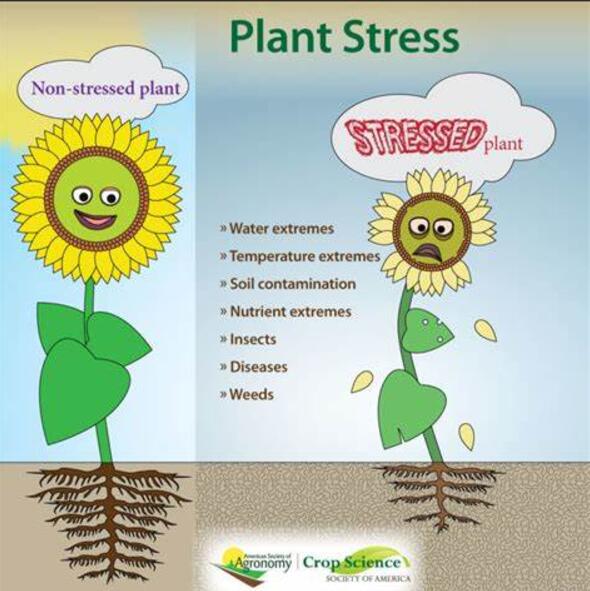Over-expression analysis of TaDWF4˗4B in mutant wheat lines identifies a candidate regulator of heat stress tolerance
IF 6.8
Q1 PLANT SCIENCES
引用次数: 0
Abstract
Wheat production faces great threat due to rising environmental temperatures resulting from climate change. Here we analyzed a bulk of wheat exotic, elite, synthetic and local wheat lines to evaluate the impact of heat stress on the physiological and biochemical parameters of different genotypes. Mutant susceptible genotypes were generated by treating with Ethyl Methane Sulfonate (EMS) and its performance was evaluated under normal and heat stress conditions. Based on the heat stress index and yield measurement, the lines were grouped into four classes, i.e. tolerant (T), Susceptible (S), moderately tolerant (MT), and moderately susceptible (MS). The results showed significant impact of heat stress on all parameters of the tested gene pool; however, the affect was less intense on the tolerant lines compared to the other classes. To validate heat stress tolerance, we conducted RNA sequencing analysis and identified eight genes associated with heat tolerance. Among them, TaDWF4˗4B showed highest expression under heat stress condition and selected for further functional analysis. Overexpression of TaDWF4˗4B in the wheat line ESWYT-4 enhanced heat tolerance. Treatment with 2 μM brassinosteroids (BR) decreased seed germination in the transgenic lines, suggesting that TaDWF4˗4B enhances BR response. Endogenous BR contents increased in overexpression lines, along with increasing the expression of several BR biosynthetic pathway genes in overexpression line under heat stress condition. Moreover, the overexpression of TaDWF4˗4B improved reactive oxygen species (ROS) scavenging by increasing the activities of TaCAT3, TaSOD1, and TaGPx1-D under heat stress condition. These findings indicate that TaDWF4˗4B plays an important role in regulating BR biosynthesis, increasing BR response, and ROS scavenging under heat stress condition. These results present mechanistic insights into the role of TaDWF4˗4B in plant responses under heat stress condition.
TaDWF4在小麦突变系中的过表达分析——确定一个候选的耐热性调控因子
由于气候变化导致的环境温度上升,小麦生产面临巨大威胁。本文以小麦外来系、优质系、合成系和地方系为材料,分析了热胁迫对不同基因型小麦生理生化指标的影响。用甲烷磺酸乙酯(EMS)处理产生易感突变体基因型,并在正常和热胁迫条件下对其性能进行了评价。根据热胁迫指数和产量测定,将材料分为耐高温(T)、敏感高温(S)、中度耐高温(MT)和中度敏感高温(MS) 4类。结果表明:热胁迫对所测基因库各项参数均有显著影响;然而,与其他品系相比,耐受性品系的影响较小。为了验证耐热性,我们进行了RNA测序分析,鉴定了8个与耐热性相关的基因。其中,TaDWF4在热应激条件下表达最高,并被选中进行进一步的功能分析。在小麦品系ESWYT-4中过表达TaDWF4,增强其耐热性。2 μM油菜素类固醇(brassinosteroids, BR)对转基因株系的种子萌发有抑制作用,表明TaDWF4能增强对BR的响应。热胁迫条件下,过表达系内源BR含量增加,多个BR生物合成途径基因的表达量增加。此外,在热应激条件下,过表达TaDWF4,通过提高TaCAT3、TaSOD1和TaGPx1-D的活性,提高对活性氧(ROS)的清除能力。上述结果表明,在热应激条件下,TaDWF4对BR的生物合成、BR应答和ROS清除具有重要的调节作用。这些结果揭示了TaDWF4 - 4B在植物热胁迫响应中的作用机制。
本文章由计算机程序翻译,如有差异,请以英文原文为准。
求助全文
约1分钟内获得全文
求助全文
来源期刊

Plant Stress
PLANT SCIENCES-
CiteScore
5.20
自引率
8.00%
发文量
76
审稿时长
63 days
期刊介绍:
The journal Plant Stress deals with plant (or other photoautotrophs, such as algae, cyanobacteria and lichens) responses to abiotic and biotic stress factors that can result in limited growth and productivity. Such responses can be analyzed and described at a physiological, biochemical and molecular level. Experimental approaches/technologies aiming to improve growth and productivity with a potential for downstream validation under stress conditions will also be considered. Both fundamental and applied research manuscripts are welcome, provided that clear mechanistic hypotheses are made and descriptive approaches are avoided. In addition, high-quality review articles will also be considered, provided they follow a critical approach and stimulate thought for future research avenues.
Plant Stress welcomes high-quality manuscripts related (but not limited) to interactions between plants and:
Lack of water (drought) and excess (flooding),
Salinity stress,
Elevated temperature and/or low temperature (chilling and freezing),
Hypoxia and/or anoxia,
Mineral nutrient excess and/or deficiency,
Heavy metals and/or metalloids,
Plant priming (chemical, biological, physiological, nanomaterial, biostimulant) approaches for improved stress protection,
Viral, phytoplasma, bacterial and fungal plant-pathogen interactions.
The journal welcomes basic and applied research articles, as well as review articles and short communications. All submitted manuscripts will be subject to a thorough peer-reviewing process.
 求助内容:
求助内容: 应助结果提醒方式:
应助结果提醒方式:


